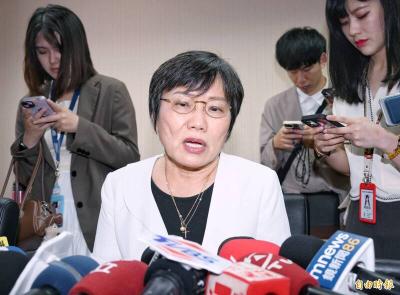A new study by the Washington-based Jamestown Foundation concludes that despite the political heat being generated by Taiwan’s presidential election, “there appears to be a degree of convergence in the cross-strait policies of the two parties.”
“The outpouring of media attention on Taiwan’s elections has distorted public perception, since much of the public discussions have been guided by subjective interpretations that fuel misconceptions regarding the degree of polarization in Taiwanese politics,” it says.
Written by Russell Hsiao, a research fellow at the Project 2049 Institute, the study says the race between President Ma Ying-jeou (馬英九) of the Chinese Nationalist Party (KMT) and Democratic Progressive Party Chairperson Tsai Ing-wen (蔡英文) remains too close to call.
“Whether President Ma wins a second term or Taiwanese voters decide to give the DPP a second chance, the driving force is becoming less and less about independence or unification,” the study says.
“The DPP’s cross-strait policy is a clear reflection of that trend,” Hsiao writes.
“In either case, Taiwan is not on an inevitable path of reunification under the People’s Republic of China nor is it headed in an inseparable path toward independence,” he says.
Hsiao concludes that the tight race, coupled with the fact that an overwhelming majority of Taiwanese voters prefer the “status quo,” means that voters will not accept — nor could any political party commit to — making any “dramatic shift.”
Hsiao says there has been a fundamental shift in Taiwanese politics since 2008.
“Democratization in Taiwan and its elections in particular — which some observers have come to see as a flash point of instability — appear to have become a stabilizing force for cross-strait relations,” he writes.
“The sooner Washington and Beijing start listening to Taiwanese voters and stop treating each presidential election in Taiwan as a zero-sum game, the faster Taiwan’s democratic consolidation could turn out to be the silver lining for Washington and Beijing for ensuring a peaceful and stable cross-strait environment,” he writes.
Hsiao says that an analysis of recent polls in Taiwan shows that despite the rapid expansion of cross-strait ties under the KMT government — which include seven rounds of cross-strait talks, 16 agreements and one “consensus” on Chinese investment in Taiwan — the people “still overwhelmingly prefer the status quo to any alternatives.”
“Furthermore, this trend suggests fears over increasing economic integration between Taiwan and China would lead to political integration have not materialized in the past four years,” he says.
“Whether it will in the long term remains to be seen. The short and medium term trends, however, indicate there is at best a weak correlation between increasing economic ties and a change in the people’s preference for independence or unification,” he writes.
It appears increasingly clear, he says, that unilateral changes by either party toward unification or independence would not be widely supported by voters.
Unless Beijing decides to intimidate Taiwanese voters by launching missile tests over the Taiwan Strait as they did in the 1995-1996 missile crises, or renounce the use of force and withdraw the array of missiles now threatening the island, or if Washington revokes the Taiwan Relations Act, the status quo is likely to remain as it is for the foreseeable future, the Jamestown study says.

Chinese Nationalist Party (KMT) Chairman Eric Chu (朱立倫), spokeswoman Yang Chih-yu (楊智伃) and Legislator Hsieh Lung-chieh (謝龍介) would be summoned by police for questioning for leading an illegal assembly on Thursday evening last week, Minister of the Interior Liu Shyh-fang (劉世芳) said today. The three KMT officials led an assembly outside the Taipei City Prosecutors’ Office, a restricted area where public assembly is not allowed, protesting the questioning of several KMT staff and searches of KMT headquarters and offices in a recall petition forgery case. Chu, Yang and Hsieh are all suspected of contravening the Assembly and Parade Act (集會遊行法) by holding

PRAISE: Japanese visitor Takashi Kubota said the Taiwanese temple architecture images showcased in the AI Art Gallery were the most impressive displays he saw Taiwan does not have an official pavilion at the World Expo in Osaka, Japan, because of its diplomatic predicament, but the government-backed Tech World pavilion is drawing interest with its unique recreations of works by Taiwanese artists. The pavilion features an artificial intelligence (AI)-based art gallery showcasing works of famous Taiwanese artists from the Japanese colonial period using innovative technologies. Among its main simulated displays are Eastern gouache paintings by Chen Chin (陳進), Lin Yu-shan (林玉山) and Kuo Hsueh-hu (郭雪湖), who were the three young Taiwanese painters selected for the East Asian Painting exhibition in 1927. Gouache is a water-based

Taiwan would welcome the return of Honduras as a diplomatic ally if its next president decides to make such a move, Minister of Foreign Affairs Lin Chia-lung (林佳龍) said yesterday. “Of course, we would welcome Honduras if they want to restore diplomatic ties with Taiwan after their elections,” Lin said at a meeting of the legislature’s Foreign Affairs and National Defense Committee, when asked to comment on statements made by two of the three Honduran presidential candidates during the presidential campaign in the Central American country. Taiwan is paying close attention to the region as a whole in the wake of a

OFF-TARGET: More than 30,000 participants were expected to take part in the Games next month, but only 6,550 foreign and 19,400 Taiwanese athletes have registered Taipei city councilors yesterday blasted the organizers of next month’s World Masters Games over sudden timetable and venue changes, which they said have caused thousands of participants to back out of the international sporting event, among other organizational issues. They also cited visa delays and political interference by China as reasons many foreign athletes are requesting refunds for the event, to be held from May 17 to 30. Jointly organized by the Taipei and New Taipei City governments, the games have been rocked by numerous controversies since preparations began in 2020. Taipei City Councilor Lin Yen-feng (林延鳳) said yesterday that new measures by